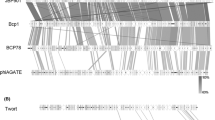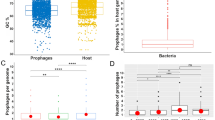Abstract
The genomes of 22 putative prophages (bifidoprophages), previously identified in bifidobacterial genomes, were analyzed to detect the presence and organization of functional modules. Bifidoprophages were shown to display a classical modular genomic organization in which the DNA lysogeny module and the DNA packaging regions are the most highly conserved. Furthermore, single phage gene as well as multiple phage gene-based phylogenetic analyses clearly revealed the chimeric make-up of the genomes of bifidoprophages.







Similar content being viewed by others
References
Ackermann HW (1998) Tailed bacteriophages: the order caudovirales. Adv Virus Res 51:135–201
Botstein D (1980) A theory of modular evolution for bacteriophages. Ann NY Acad Sci 354:484–490
Brussow H (2001) Phages of dairy bacteria. Annu Rev Microbiol 55:283–303
Bruttin A, Desiere F, Lucchini S, Foley S, Brussow H (1997) Characterization of the lysogeny DNA module from the temperate Streptococcus thermophilus bacteriophage phi Sfi21. Virology 233(1):136–148
Canchaya C, Proux C, Fournous G, Bruttin A, Brussow H (2003) Prophage genomics. Microbiol Mol Biol Rev 67(2):238–276 table of contents
Casjens SR (2005) Comparative genomics and evolution of the tailed-bacteriophages. Curr Opin Microbiol 8(4):451–458
Desiere F, Lucchini S, Brussow H (1999) Comparative sequence analysis of the DNA packaging, head, and tail morphogenesis modules in the temperate cos-site Streptococcus thermophilus bacteriophage Sfi21. Virology 260(2):244–253
Desiere F, Mahanivong C, Hillier AJ, Chandry PS, Davidson BE, Brussow H (2001) Comparative genomics of lactococcal phages: insight from the complete genome sequence of Lactococcus lactis phage BK5-T. Virology 283(2):240–252
Gasson MJ (1996) Lytic systems in lactic acid bacteria and their bacteriophages. Antonie Van Leeuwenhoek 70(2–4):147–159
Groth AC, Calos MP (2004) Phage integrases: biology and applications. J Mol Biol 335(3):667–678
Hatfull GF, Sarkis GJ (1993) DNA sequence, structure and gene expression of mycobacteriophage L5: a phage system for mycobacterial genetics. Mol Microbiol 7(3):395–405
Hatfull GF, Pedulla ML, Jacobs-Sera D, Cichon PM, Foley A, Ford ME, Gonda RM, Houtz JM, Hryckowian AJ, Kelchner VA, Namburi S, Pajcini KV, Popovich MG, Schleicher DT, Simanek BZ, Smith AL, Zdanowicz GM, Kumar V, Peebles CL, Jacobs WR Jr, Lawrence JG, Hendrix RW (2006) Exploring the mycobacteriophage metaproteome: phage genomics as an educational platform. PLoS Genet 2(6):e92
Hendrix RW, Roberts JW, Sthal FW, Weisberg RA (1984) Lambda II. Cold Spring Harbor Labortaory, Cold Spring Harbor, New York
Hendrix RW, Smith MC, Burns RN, Ford ME, Hatfull GF (1999) Evolutionary relationships among diverse bacteriophages and prophages: all the world’s a phage. Proc Natl Acad Sci USA 96(5):2192–2197
Lucchini S, Desiere F, Brussow H (1999a) The genetic relationship between virulent and temperate Streptococcus thermophilus bacteriophages: whole genome comparison of cos-site phages Sfi19 and Sfi21. Virology 260(2):232–243
Lucchini S, Desiere F, Brussow H (1999b) Similarly organized lysogeny modules in temperate Siphoviridae from low GC content gram-positive bacteria. Virology 263(2):427–435
McGrath S, Fitzgerald GF, van Sinderen D (2002) Identification and characterization of phage-resistance genes in temperate lactococcal bacteriophages. Mol Microbiol 43(2):509–520
Mediavilla J, Jain S, Kriakov J, Ford ME, Duda RL, Jacobs WR Jr, Hendrix RW, Hatfull GF (2000) Genome organization and characterization of mycobacteriophage Bxb1. Mol Microbiol 38(5):955–970
Payne K, Sun Q, Sacchettini J, Hatfull GF (2009) Mycobacteriophage Lysin B is a novel mycolylarabinogalactan esterase. Mol Microbiol 73(3):367–381
Pedulla ML, Ford ME, Houtz JM, Karthikeyan T, Wadsworth C, Lewis JA, Jacobs-Sera D, Falbo J, Gross J, Pannunzio NR, Brucker W, Kumar V, Kandasamy J, Keenan L, Bardarov S, Kriakov J, Lawrence JG, Jacobs WR Jr, Hendrix RW, Hatfull GF (2003) Origins of highly mosaic mycobacteriophage genomes. Cell 113(2):171–182
Pena CE, Lee MH, Pedulla ML, Hatfull GF (1997) Characterization of the mycobacteriophage L5 attachment site, attP. J Mol Biol 266(1):76–92
Sampson T, Broussard GW, Marinelli LJ, Jacobs-Sera D, Ray M, Ko CC, Russell D, Hendrix RW, Hatfull GF (2009) Mycobacteriophages BPs, Angel and Halo: comparative genomics reveals a novel class of ultra-small mobile genetic elements. Microbiology 155(Pt 9):2962–2977
Smith MC, Burns RN, Wilson SE, Gregory MA (1999) The complete genome sequence of the Streptomyces temperate phage straight phiC31: evolutionary relationships to other viruses. Nucleic Acids Res 27(10):2145–2155
Sternberg N, Coulby J (1987) Recognition and cleavage of the bacteriophage P1 packaging site (pac). II. Functional limits of pac and location of pac cleavage termini. J Mol Biol 194(3):469–479
Teichmann SA, Mitchison G (1999) Is there a phylogenetic signal in prokaryote proteins? J Mol Evol 49(1):98–107
Tetart F, Desplats C, Krisch HM (1998) Genome plasticity in the distal tail fiber locus of the T-even bacteriophage: recombination between conserved motifs swaps adhesin specificity. J Mol Biol 282(3):543–556
Turroni F, Foroni E, Pizzetti P, Giubellini V, Ribbera A, Merusi P, Cagnasso P, Bizzarri B, de’Angelis GL, Shanahan F, van Sinderen D, Ventura M (2009a) Exploring the diversity of the bifidobacterial population in the human intestinal tract. Appl Environ Microbiol 75(6):1534–1545
Turroni F, Marchesi JR, Foroni E, Gueimonde M, Shanahan F, Margolles A, van Sinderen D, Ventura M (2009b) Microbiomic analysis of the bifidobacterial population in the human distal gut. ISME J 3(6):745–751
Ventura M, Lee JH, Canchaya C, Zink R, Leahy S, Moreno-Munoz JA, O’Connell-Motherway M, Higgins D, Fitzgerald GF, O’Sullivan DJ, van Sinderen D (2005) Prophage-like elements in bifidobacteria: insights from genomics, transcription, integration, distribution, and phylogenetic analysis. Appl Environ Microbiol 71(12):8692–8705
Ventura M, Canchaya C, Tauch A, Chandra G, Fitzgerald GF, Chater KF, van Sinderen D (2007) Genomics of Actinobacteria: tracing the evolutionary history of an ancient phylum. Microbiol Mol Biol Rev 71(3):495–548
Ventura M, O’Flaherty S, Claesson MJ, Turroni F, Klaenhammer TR, van Sinderen D, O’Toole P (2009a) Genome-scale analyses of health-promoting bacteria: probiogenomics. Nat Rev Microbiol 7(1):61–71
Ventura M, Turroni F, Lima-Mendez G, Foroni E, Zomer A, Duranti S, Giubellini V, Bottacini F, Horvath P, Barrangou R, Sela DA, Mills DA, van Sinderen D (2009b) Comparative analyses of prophage-like elements present in bifidobacterial genomes. Appl Environ Microbiol 75(21):6929–6936
Acknowledgments
This material is based upon works supported by a Principal Investigator Grant (to DvS, grant number 08/IN.1/B1909) and the Alimentary Pharmabiotic Centre, a Centre for Science and Technology, both funded by Science Foundation Ireland (SFI) through the Irish Government’s National Development Plan, by the Italian Award for Outstanding Young Researcher scheme “Incentivazione alla mobilita’ di studiosi stranieri e italiani residenti all’estero” and to the Marie Curie Reintegration Grant (MERG-CT-2005-03080) to MV and by an IRCSET Embark postgraduate fellowship to F.B. The project described was partially supported by NIH-NIGMS T32-GM08799 (DAS). Its contents are solely the responsibility of the authors and do not necessarily represent the official views of the NIGMS or NIH.
Author information
Authors and Affiliations
Corresponding author
Electronic supplementary material
Below is the link to the electronic supplementary material.
Rights and permissions
About this article
Cite this article
Ventura, M., Turroni, F., Foroni, E. et al. Analyses of bifidobacterial prophage-like sequences. Antonie van Leeuwenhoek 98, 39–50 (2010). https://doi.org/10.1007/s10482-010-9426-4
Received:
Accepted:
Published:
Issue Date:
DOI: https://doi.org/10.1007/s10482-010-9426-4




